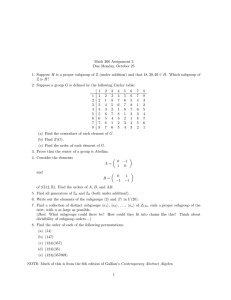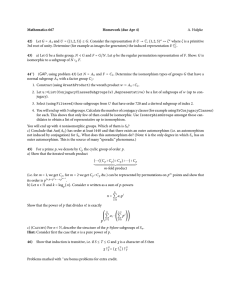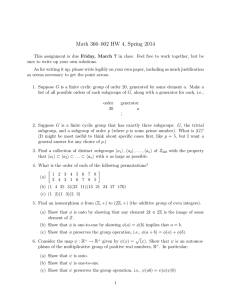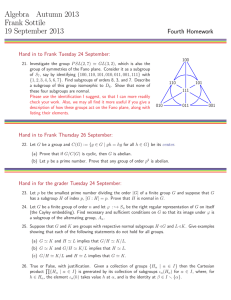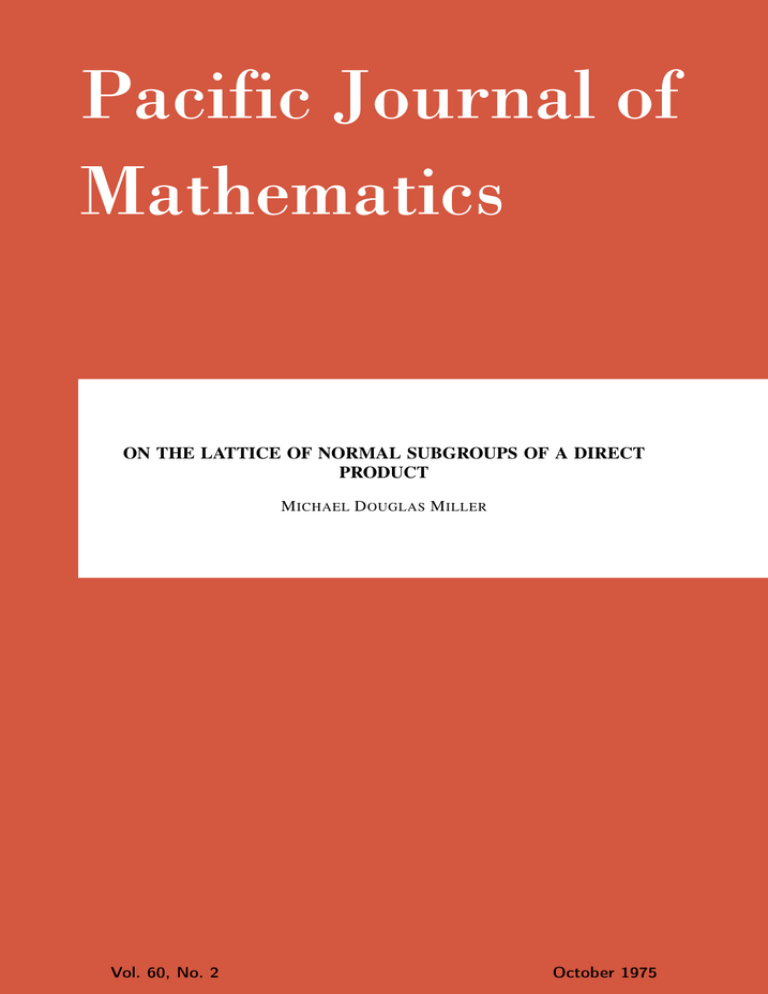
Pacific Journal of
Mathematics
ON THE LATTICE OF NORMAL SUBGROUPS OF A DIRECT
PRODUCT
M ICHAEL D OUGLAS M ILLER
Vol. 60, No. 2
October 1975
PACIFIC JOURNAL OF MATHEMATICS
Vol. 60, No. 2, 1975
ON THE LATTICE OF NORMAL SUBGROUPS
OF A DIRECT PRODUCT
MICHAEL D . MILLER
Suzuki has determined that if G is a direct product
G = Π^jG, of groups Gt ^ 1, then the lattice L ( G ) of subgroups
of G is the direct product of the lattices L(Gi) if and only if the
order of any element in G, is finite and relatively prime to the
order of any element in G,(ίV /). An exercise in Zassenhaus' The
Theory of Groups asks the reader to prove an analogous result
for the lattice of normal subgroups. In §1, we derive this result
for the case of the direct product of two groups. (The generalization to the direct product of any finite number of groups is
straightforward.) In §2, we use results obtained in §1 to study
in detail the normal subgroup lattice of the direct product of
finitely many symmetric groups.
1.
The lattice of normal subgroups.
If Gλ and G2 are
groups, we denote elements of the direct product Gx x G2 by ordered
pairs (a, />), a E Gu b E G2. If A and B are subgroups of a group G, we
ι
ι
define [A,B] = (aba~ b~ \a E A, b E B), and note that if A < G, then
[A, B]<lA. We let pi and p 2 denote the first and second projection
maps on Gλ x G2, andfinally,we denote by o(g) the order of the element
g
If N is a subgroup of Gx x G2, we put Nγ = p\{N) and JV2 =
p2(N). Thus Nι is a subgroup of G, , called the ith projection of
N. Furthermore, if N < Gx x G2, then Ns < Gf,
LEMMA
1. IfN<Gιx
G2, then N D [Gu JV,] x [G2, N 2 ].
Proof. Let a E Nλ. Then there exists y E N 2 such that (a,y)E
N. Thus ( α ^ y - ^ E N , and since N<GιxG2,
(g, l)(α, yXg'1,1) =
ι
(g^gΛ y) e N. It follows that (gag-\ y){a'\ y~ ) - (gag^a~\ 1) E ΛΓ, so
N D [Gu NJ X {1}. Similarly, N D {1} x [G2, N 2 ], completing the proof.
The following lemma, whose proof is immediate, will be used in the
discussion that follows.
2. Let G be a group, H < G.
such that [G,H]CL CH is normal in G.
LEMMA
Then any subgroup L of G
Since [GλxG2,A x J5] = [Gu A] x [G 2 ,B] whenever
ACGUBC
G2, if N < Gi x G 2 with projections Nx and N 2 , then any subgroup of
GiXG 2 lying between [GuNi]x[G2,N2]
and Nx x N2 is normal in
153
154
MICHAEL D. MILLER
Gί x G2. Moreover, as [Nh Nt] C [Gh Λζ-], we see that Q = Ni /[Gf , Nj] is
abelian, as is d x C2 = (ΛΓi x N2)/[GU Nt] x [G2, N 2 ]. There is thus a 1-1
correspondence φ between subgroups of d x C2 and subgroups of
G! x G2 lying between [Gl9 Nt] x [G2, ΛΓ2] and N2 x JV2.
DEFINITION. A normal subgroup S of Gx x G2 is called Gi - G 2
decomposable if 5 = Sι x S2, Si <l G 1? S2 <l G2.
It is easy to see that a subgroup // of d x C2 is Ci - C2 decomposable if and only if φ(H) is Gx- G2 decomposable. Furthermore, if
B C C i X C2, then the ith projection of B is Q if and only if the ith
projection of φ(B) is N,.
Assuming we can determine the subgroup lattice structure of
arbitrary abelian groups, we now have a systematic way of describing the
normal subgroups of Gλ x G 2 in terms of those of Gx and G2. Namely,
choose Si <J Gi, S2 < G2 and consider the subgroups M of the abelian
group St/lGuS^x S2/[G2,S2] with the property that M, =
SJ[Gh S,]. To each such M, there corresponds a normal subgroup N of
G! x G2 with [Gu Sι] x [G2, S J C N C ^ x S2 and N, = S, . As S t and S2
run through the normal subgroups of G1 and G2 respectively, we obtain
each normal subgroup of Gλ x G 2 exactly once.
It is, of course, not always easy to determine all subgroups of a given
abelian group. For finite groups, however, Suzuki's result shows that it
suffices to consider the case of abelian p-groups.
Let Gλ = S3 (symmetric group on 3 letters)
G2 = Z2 (cyclic group of order 2)
We calculate the following:
EXAMPLE.
Si
s2
[Gu S,]
[G2, S2]
c,
c2
V
1
1
1
1
1
1
1
1
z2
1
1
1
1
z3
z2
1
1
1
1
Z3
1
1
1
z3
z3
1
z2
z2
z2
1
1
z2
2
z3
z3
s3
S3
1
z2
1
z2
1
Here Q; = Si/[Gh S, ], and ^ denotes the number of subgroups M C
d x C2 with Mi = C
From this, we see that S3 x Z2 has seven normal subgroups, all of
which are S3 - Z2 decomposable, except for one of order six.
ON THE LATTICE OF NORMAL SUBGROUPS
155
We now determine the condition for every normal subgroup of
Gx x G2 to be Gι - G2 decomposable. Recall that a group G is called
perfect if G = G'. We will say that G is super-perfect if [G, H] = H for
all H <3 G.
1. Let Gx and G2 be groups. Then every normal subgroup of Gι x G 2 is Gι - G2 decomposable if and only if either (i) at least
one of Gi and G2 is super-perfect, or (ii) for all Sx < Gx, S2 < G2, the
elements of SJ[GUSX]
have orders relatively prime to those of
S2/[G2,S2]. (In particular, these orders must be finite.)
THEOREM
Proof ( <= ) Suppose N<Gxx G2 is not Gx- G2 decomposable.
Then the subgroup φ(N) of NX/[GUNX] x N2/[G2,N2] = Cx x C2 is not
Cx~ C2 decomposable. If G, is super-perfect, then Q? = 1, a
contradiction. Otherwise (ii) holds, and we have a contradiction to
Suzuki's result [2]. ( φ ) Let 5, <3 G,. By hypothesis, every normal
subgroup NCGxxG2
with [Gx, Sx] x [G2, S J C J V C ^ x S2 is Gi - G2
decomposable, and therefore all subgroups of SX/[GX, Sx] x S2/[G2, S2] =
Ci x C2 are Cx - C2 decomposable. If Cx has elements of infinite order,
then G2 must be super-perfect. For if not, there is a normal subgroup H
of G2 such that D = H/[G2, H] ^ 1. By Suzuki's result, d x D contains
a subgroup which is not Cx - D decomposable, a contradiction. Simililarly, if Gλ is not super-perfect, then C2 must be a torsion group.
Finally, if neither Gλ nor G2 is super-perfect, then the order of any
element in Cλ must be relatively prime to the order of any element in C2,
for if not, by Suzuki's result, there would be a subgroup of CΊ x C2 which
is not Ci - C2 decomposable.
COROLLARY 1. Every normal subgroup of G x G is G - G decomposable if and only if G is super-perfect
COROLLARY 2. // Gλ and G 2 are torsion groups, and the order of any
element in Gλ is relatively prime to the order of any element in G2, then
every normal subgroup of Gx x G2 is Gx - G2 decomposable.
DEFINITION. A torsion group G is called quasi-nilpotent if for every
prime p with p = o(a) for some a E G, there exists H <3G such that
H/[G,H] has an element of order p.
It is easy to see that every nilpotent torsion group is quasinilpotent. The first example of a quasi-nilpotent group which is not
nilpotent is the group S3 x Z3, of order 18. The first indecomposable
example is SL(2,3) of order 24.
156
MICHAEL D. MILLER
We now state a partial converse to Corollary 2:
COROLLARY 3. // Gλ and G2 are quasi-nilpotent groups such that
every normal subgroup of Gλ x G2 is Gx - G2 decomposable, then the order
of any element in Gλ is relatively prime to the order of any element in G 2 .
Theorem 1 can be easily generalized to yield the following:
THEOREM. 2. Let G = Πf=1 G, . Then every normal subgroup N of G
is a direct product N = Πf=1JVi of normal subgroups N< of Gt if and only if
either (i) at most one of the G, is not super-perfect, or (ii) whenever Ht < G,
and Hj < G ; (ιV/), the order of any element in Hi/[GhHi] is relatively
prime to the order of any element in Hjl[Gj9Hj\.
(In particular, these
orders must be finite.)
The proof is identical in nature to that of Theorem 1, and will
therefore be omitted.
Instead of studying the lattice of normal subgroups, one can look at
other systems of subgroups which form a lattice. For example, one
could ask when every characteristic (resp. fully invariant) subgroup of
nf=1Gi is a direct product of characteristic (resp. fully invariant) subgroups of the individual G, . These problems appear to be substantially
more difficult than the one treated in this section.
2.
Direct products of symmetric groups. We begin
with two definitions. If G is a group and H is any subgroup containing
G', then H is called a CC-subgroup of G. All CC-subgroups are
therefore normal. Secondly, if G = IΊf=1G/ and p, is the projection on
the /th factor, then an automorphism φ of G is called rigid if φ(pi(G)) =
ρt(G) for all i. The group of rigid automorphisms of G is thus
isomorphic to Πf=1 Aut(G, ).
Now let (Sn)k be the direct product of k copies of the symmetric
group 5n, where n > 4. (The results of this section are not in general
true for n ^ 4, although analogous results may be obtained by treating
each case separately.)
We wish to determine all normal subgroups of (Sn)k. Forfc= 1,
there are exactly three: 1, An9 and Sn. Suppose the normal subgroups of
(Sn)r for r<k have been determined. Then if N<(Sn)k,
we may
assume that N is not contained in a product of fewer than k copies of
Sn. By the simplicity of A n , N D ( A n ) k and so JV is a CC-subgroup.
Now (Sn)k/(An)k
is an elementary abelian 2-group, which may be
considered as the vector space P (over Z 2 ) of subsets of the set
K = {1,2,
, fc}, where
addition
is defined
by symmetric
difference. There is therefore a 1 - 1 correspondence σ between CC-
ON THE LATTICE OF NORMAL SUBGROUPS
157
subgroups of (Sn)k and subspaces of P. We proceed to show that this
correspondence can be made canonical.
If N is a CC-subgroup of (Sn)*, let σ(N) be the subspace of P
spanned by the set of all U CK
such that ΐlieuXi E An for all
(JCI,
, x k ) £ N. Conversely, if S is a subspace of P, let N be that CCk
subgroup of (Sn) consisting of all elements (xux2,
*,**) such that
UieRXi £ Λ n for all RES.
It is easily verified that σ(N) = 5, and that σ
is a Galois correspondence, i.e., it is 1 - 1 and reverses inclusion.
For example, (Snf/(Anf
is isomorphic to the Klein group Z 2 x Z 2 ,
which has 5 subgroups (subspaces). There are therefore 5 CCsubgroups <rf (5 n ) 2 viz., (Λ π ) 2 , An x Sn, Sn x An, {(JC 1 ,X 2 )|X 1 X 2 6 An}, and
(S n ) 2 . If we add to these the subgroups 1 x 1,1 x An, An x 1,1 x Sn, and
Sn x 1, we find that there is a total of 10 normal subgroups in (5 n ) 2 .
Now eue2,'',ek
where £,={/} form a basis of P. Under σ,ex
corresponds to the subgroup of all (x 1 ,x 2 ,
,xk)E(Sn)k
such that xf is
even. We define a coordinate plane to be a subspace of P spanned by
some collection of the eh and call it proper if it has dimension < fc. It is
not hard to see that a CC-subgroup N of (Sn)k is a nontrivial direct
k
product of two normal subgroups of (Sn) if and only if σ(N) is the direct
sum of two subspaces of P, contained respectively in complementary
proper coordinate planes.
We now recall the following well-known facts:
(i) For n > 4, n ^ 6, Aut Sn = Aut A n = Sn. Moreover, Aut S6 =
Aut A 6 and [Aut S 6 : Inn S6] = 2.
(ii) (Mathewson
[1])
For
n > 4,
Aut (Sn )k = Aut (AB )k =
In words, eyery automorphism of Sn(n > 4 , ny^β) is inner, while
every automorphism of (Sn)k(n > 4 , n^ 6) is the product of an inner
automorphism and an automorphism which permutes the k factors. For
k
n > 4, the automorphism group of An (resp. (An) ) is the same as that of
k
Sn (resp. (Sn) ).
k
3. Let N be a CC-subgroup of (Sn) .
Then every
k
automorphism of N is induced by an automorphism of (Sn) .
THEOREM
Proof Let θ G Aut N. By the above, the action of θ on (Anf is
that of the product of a rigid automorphism of (A n )k and an automorphism which permutes the k factors of (An)k.
Multiplying θ by a rigid
automorphism of (Sn)k (itself an automorphism of JV), we may assume
that the action of θ on (An)k is simply a permutation TΓ of the k factors.
Let xEN
with θ(x) = y and eE(An)k
with θ{e) = e". Since
-1
x
x ex E(A n )*, we have Q(x~ ex)~ x'^e^x^.
But also β(jc"1ejc) =
π
2
y^e'y. As e is arbitrary in (A n )\ x y~ is in the centralizer of (An)fc,
which is trivial, so y = x π . Thus every automorphism of N is the
158
MICHAEL D. MILLER
k
product of a rigid automorphism of (Sn) and an automorphism which
permutes the k factors. The theorem follows.
In general, not all automorphisms of (Sn)k actually restrict to
automorphisms of a given CC- subgroup JV, since not all permutations of
the k factors leave N invariant. If S = σ(N) is the corresponding
subspace of P, let Γ denote the group of permutation matrices (with
respect to the basis eue29 —,ek) which leave 5 invariant. Then
= (AutSn)fc xs Γ.
The characteristic subgroups of (Sn)k are:
and Γ2, where Tλ = {(xu x2,
, Jck)|Πf=1x,, e An}9 and
, Xk)\ΐlι<pCiXj E An for all /,/}. (Note that Tx = T2 in case
THEOREM 4.
l,(Sn)\(An)\Tu
T2 = {(xu *2,
fc=2.)
Proof It is clear that except for 1, any characteristic subgroup of
k
k
(Sn) contains (An) , for otherwise it would be contained in a direct
product of fewer than k copies of Sn, and hence not be characteristic. In
terms of P, we must show that the only subspaces 5 invariant under all
permutations of the coordinates are 0 , P9 the 1-dimensional subspace Vx
spanned by eλ + e2λ
+ ek, and the (k — l)-dimensional subspace V2
spanned by all eι + er
That these are all invariant is immediate. Assume now that 5 is
invariant, and suppose that axeλ +
+ arer H
+ a5es +
4- akek G 5,
where ar + as ^ 0 for some choice of r and s (otherwise S = 0 or
S = Vi). By invariance, α^i +
+ ares +
+ aser 4+ akek G 5,
and adding gives (ar + as)er + (αr + as)es G S, so that er + es G 5. Again
by invariance, we conclude that e{ + e^S for all i, /, so either S = P or
S = V2.
The question of determining exactly which groups can arise as the
group Γ of "admissible" permutation matrices for a given CC-subgroup
N will be dealt with in a future paper.
REFERENCES
1. L. C. Mathewson, Theorems on the groups of isomorphisms of certain groups, Amer. J. Math., 38
(1916), 19-44.
2. M. Suzuki, Structure of a Group and the Structure of its Lattice of Subgroups, Springer-Verlag,
1967.
3. H. Zassenhaus, The Theory of Groups, Chelsea, 1958.
Received September 3, 1974, and in revised form October 14, 1974.
UNIVERSITY OF CALIFORNIA, BERKELEY
PACIFIC JOURNAL OF MATHEMATICS
EDITORS
RICHARD ARENS
(Managing Editor)
J. DUGUNDJI
University of California
Los Angeles, California 90024
Department of Mathematics
University of Southern California
Los Angeles, California 90007
R. A. BEAUMONT
D . GlLBARG AND J. MlLGRAM
Stanford University
Stanford, California 94305
University of Washington
Seattle, Washington 98105
ASSOCIATE EDITORS
E F. BECKENBACH
B. H. NEUMANN
R WOLF
K. YOSHIDA
SUPPORTING INSTITUTIONS
UNIVERSITY OF BRITISH COLUMBIA
CALIFORNIA INSTITUTE OF TECHNOLOGY
UNIVERSITY OF CALIFORNIA
MONTANA STATE UNIVERSITY
UNIVERSITY OF NEVADA
NEW MEXICO STATE UNIVERSITY
OREGON STATE UNIVERSITY
UNIVERSITY OF OREGON
OSAKA UNIVERSITY
UNIVERSITY OF SOUTHERN CALIFORNIA
STANFORD UNIVERSITY
UNIVERSITY OF TOKYO
UNIVERSITY OF UTAH
WASHINGTON STATE UNIVERSITY
UNIVERSITY OF WASHINGTON
AMERICAN MATHEMATICAL SOCIETY
The Supporting Institutions listed above contribute to the cost of publication of this Journal, but
they are not owners or publishers and have no responsibility for its contents or policies.
Mathematical papers intended for publication in the Pacific Journal of Mathematics should be in typed
form or offset-reproduced (not dittoed), double spaced with large margins. Underline Greek letters in red,
German in green, and script in blue. The first paragraph or two must be capable of being used separately
as a synopsis of the entire paper. Items of the bibliography should not be cited there unless absolutely necessary, in which case they must be identified by author and Journal, rather than by item number. Manuscripts,
in duplicate, may be sent to any one of the four editors. Please classify according to the scheme
of Math. Reviews, Index to Vol. 39. All other communications should be addressed to the managing
editor, or Elaine Barth, University of California, Los Angeles, California, 90024.
100 reprints are provided free for each article, only if page charges have been substantially paid.
Additional copies may be obtained at cost in multiples of 50.
The Pacific Journal of Mathematics is issued monthly as of January 1966. Regular subscription rate:
$72.00 a year (6 Vols., 12 issues). Special rate: $36.00 a year to individual members of supporting
institutions.
Subscriptions, orders for back numbers, and changes of address should be sent to Pacific Journal of
Mathematics, 103 Highland Boulevard, Berkeley, California, 94708.
PUBLISHED BY PACIFIC JOURNAL OF MATHEMATICS, A NON-PROFIT CORPORATION
Printed at Jerusalem Academic Press, POB 2390, Jerusalem, Israel.
Copyright © 1975 Pacific Journal of Mathematics
All Rights Reserved
Pacific Journal of Mathematics
Vol. 60, No. 2
October, 1975
Waleed A. Al-Salam and A. Verma, A fractional Leibniz q-formula . . . . . . . . . . . . .
Robert A. Bekes, Algebraically irreducible representations of L 1 (G). . . . . . . . . . . .
Thomas Theodore Bowman, Construction functors for topological
semigroups . . . . . . . . . . . . . . . . . . . . . . . . . . . . . . . . . . . . . . . . . . . . . . . . . . . . . . . . . . .
Stephen LaVern Campbell, Operator-valued inner functions analytic on the
closed disc. II . . . . . . . . . . . . . . . . . . . . . . . . . . . . . . . . . . . . . . . . . . . . . . . . . . . . . . . . .
Leonard Eliezer Dor and Edward Wilfred Odell, Jr., Monotone bases in L p . . . . . .
Yukiyoshi Ebihara, Mitsuhiro Nakao and Tokumori Nanbu, On the existence of
global classical solution of initial-boundary value problem for
cmu − u 3 = f . . . . . . . . . . . . . . . . . . . . . . . . . . . . . . . . . . . . . . . . . . . . . . . . . . . . . . . .
Y. Gordon, Unconditional Schauder decompositions of normed ideals of
operators between some l p -spaces . . . . . . . . . . . . . . . . . . . . . . . . . . . . . . . . . . . . . .
Gary Grefsrud, Oscillatory properties of solutions of certain nth order functional
differential equations . . . . . . . . . . . . . . . . . . . . . . . . . . . . . . . . . . . . . . . . . . . . . . . . . .
Irvin Roy Hentzel, Generalized right alternative rings . . . . . . . . . . . . . . . . . . . . . . . . .
Zensiro Goseki and Thomas Benny Rushing, Embeddings of shape classes of
compacta in the trivial range . . . . . . . . . . . . . . . . . . . . . . . . . . . . . . . . . . . . . . . . . . .
Emil Grosswald, Brownian motion and sets of multiplicity . . . . . . . . . . . . . . . . . . . . .
Donald LaTorre, A construction of the idempotent-separating congruences on a
bisimple orthodox semigroup . . . . . . . . . . . . . . . . . . . . . . . . . . . . . . . . . . . . . . . . . . .
Pjek-Hwee Lee, On subrings of rings with involution . . . . . . . . . . . . . . . . . . . . . . . . . .
Marvin David Marcus and H. Minc, On two theorems of Frobenius . . . . . . . . . . . . .
Michael Douglas Miller, On the lattice of normal subgroups of a direct
product . . . . . . . . . . . . . . . . . . . . . . . . . . . . . . . . . . . . . . . . . . . . . . . . . . . . . . . . . . . . . . .
Grattan Patrick Murphy, A metric basis characterization of Euclidean space . . . . .
Roy Martin Rakestraw, A representation theorem for real convex functions . . . . . .
Louis Jackson Ratliff, Jr., On Rees localities and Hi -local rings . . . . . . . . . . . . . . . .
Simeon Reich, Fixed point iterations of nonexpansive mappings . . . . . . . . . . . . . . . .
Domenico Rosa, B-complete and Br -complete topological algebras . . . . . . . . . . . .
Walter Roth, Uniform approximation by elements of a cone of real-valued
functions . . . . . . . . . . . . . . . . . . . . . . . . . . . . . . . . . . . . . . . . . . . . . . . . . . . . . . . . . . . . .
Helmut R. Salzmann, Homogene kompakte projektive Ebenen . . . . . . . . . . . . . . . . . .
Jerrold Norman Siegel, On a space between B H and B∞ . . . . . . . . . . . . . . . . . . . . . .
Robert C. Sine, On local uniform mean convergence for Markov operators . . . . . .
James D. Stafney, Set approximation by lemniscates and the spectrum of an
operator on an interpolation space . . . . . . . . . . . . . . . . . . . . . . . . . . . . . . . . . . . . . .
Árpád Száz, Convolution multipliers and distributions . . . . . . . . . . . . . . . . . . . . . . . . .
Kalathoor Varadarajan, Span and stably trivial bundles . . . . . . . . . . . . . . . . . . . . . . . .
Robert Breckenridge Warfield, Jr., Countably generated modules over
commutative Artinian rings . . . . . . . . . . . . . . . . . . . . . . . . . . . . . . . . . . . . . . . . . . . . .
John Yuan, On the groups of units in semigroups of probability measures . . . . . . . .
1
11
27
37
51
63
71
83
95
103
111
115
131
149
153
159
165
169
195
199
209
217
235
247
253
267
277
289
303



